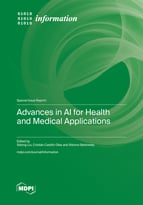Advances in AI for Health and Medical Applications
A special issue of Information (ISSN 2078-2489). This special issue belongs to the section "Artificial Intelligence".
Deadline for manuscript submissions: closed (15 December 2023) | Viewed by 34871
Special Issue Editors
Interests: medical informatics; medical image computing; machine learning
Special Issues, Collections and Topics in MDPI journals
Interests: machine learning; deep learning; big data mining; health applications
Special Issue Information
Dear Colleagues,
The MDPI Information Journal invites submissions to a Special Issue on “Advances in AI for Health and Medical Applications”.
The design and use of Artificial Intelligence (AI) and digital technologies is driving fundamental changes in healthcare. AI allows us to imagine new and improved ways of delivering care. It has the capacity to make significant contributions to solving modern healthcare challenges, such as the growing burden of chronic illness, over-treatment and diagnostic error, resulting in potential patient harm and resource waste. Through AI, we may exploit patterns in large-scale clinical datasets and build advanced computational reasoning methods that support human decision-making.
Encouraging results have been reported, suggesting that AI has become so powerful that it outreasons human experts in areas such as radiology or dermatology. It will soon be routine to see AI applied to every aspect of healthcare and medicine, from screening through to diagnosis, treatment and population health. However, clinical specialties like radiology might not disappear, but they will certainly be heavily transformed, and clinicians will have a major new role in the time of AI.
This Special Issue is concerned with groundbreaking topics on recent advances in AI for health and medical applications. The areas of interest include (but are not limited to):
- Applications of AI in healthcare;
- Clinician interaction with AI;
- AI-augmented decision support;
- Trust and automation bias in medical applications;
- AI-powered behavioural change support systems;
- AI and HCI methods for health big data mining;
- AI for enhancing safety, quality, access and efficiency of care;
- Personal health information management;
- Network processes and digital epidemiology;
- Health misinformation on social media;
- Sensing technologies and wearable devices for health applications.
Paper length must be 9–15 pages and papers should be formatted according to the MDPI template. Complete instructions for authors can be found at: https://www.mdpi.com/journal/information/instructions.
Dr. Sidong Liu
Dr. Cristián Castillo Olea
Dr. Shlomo Berkovsky
Guest Editors
Manuscript Submission Information
Manuscripts should be submitted online at www.mdpi.com by registering and logging in to this website. Once you are registered, click here to go to the submission form. Manuscripts can be submitted until the deadline. All submissions that pass pre-check are peer-reviewed. Accepted papers will be published continuously in the journal (as soon as accepted) and will be listed together on the special issue website. Research articles, review articles as well as short communications are invited. For planned papers, a title and short abstract (about 100 words) can be sent to the Editorial Office for announcement on this website.
Submitted manuscripts should not have been published previously, nor be under consideration for publication elsewhere (except conference proceedings papers). All manuscripts are thoroughly refereed through a single-blind peer-review process. A guide for authors and other relevant information for submission of manuscripts is available on the Instructions for Authors page. Information is an international peer-reviewed open access monthly journal published by MDPI.
Please visit the Instructions for Authors page before submitting a manuscript. The Article Processing Charge (APC) for publication in this open access journal is 1600 CHF (Swiss Francs). Submitted papers should be well formatted and use good English. Authors may use MDPI's English editing service prior to publication or during author revisions.








